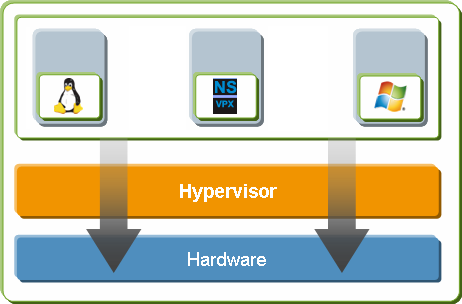Install a Citrix® ADC VPX instance on XenServer®
To install VPX instances on Citrix XenServer, you must first install XenServer on a machine with adequate system resources. To perform the Citrix ADC VPX instance installation, you use Citrix XenCenter®, which must be installed on a remote machine that can connect to the XenServer host through the network.
For more information about XenServer, see XenServer documentation.
The following figure shows the bare-metal solution architecture of Citrix ADC VPX instance on XenServer.
Figure. A Citrix ADC VPX instance on XenServer

Prerequisites for installing a Citrix ADC VPX instance on XenServer
Before you begin installing a virtual appliance, do the following:
- Install XenServer version 6.0 or later on hardware that meets the minimum requirements.
- Install XenCenter on a management workstation that meets the minimum system requirements.
- Obtain virtual appliance license files. For more information about virtual appliance licenses, see the Citrix ADC Licensing Guide.
XenServer hardware requirements
The following table describes the minimum hardware requirements for a XenServer platform running a Citrix ADC VPX instance.
Table 1. Minimum system requirements for XenServer running a nCore VPX instance
| Component | Requirement |
|---|---|
| CPU | 2 or more 64-bit x86 CPUs with virtualization assist (Intel-VT) enabled. AMD processor is not supported. To run Citrix ADC VPX instance, hardware support for virtualization must be enabled on the XenServer host. Make sure that the BIOS option for virtualization support is not disabled. For more details, see BIOS documentation. |
| RAM | 3 GB |
| Disk space | Locally attached storage (PATA, SATA, SCSI) with 40 GB of disk space. Note: XenServer installation creates a 4 GB partition for the XenServer host control domain; the remaining space is available for Citrix ADC VPX instance and other virtual machines. |
| NIC | One 1-Gbps NIC; recommended: two 1-Gbps NICs |
For information about installing XenServer, see the XenServer documentation at http://support.citrix.com/product/xens/.
The following table lists the virtual computing resources that XenServer must provide for each nCore VPX virtual appliance.
Table 2. Minimum virtual computing resources required for running a ncore VPX instance
| Component | Requirement |
|---|---|
| Memory | 2 GB |
| Virtual CPU (VCPU) | 2 |
| Virtual network interfaces | 2 |
Note:
For production use of Citrix ADC VPX instance, Citrix recommends that CPU priority (in virtual machine properties) be set to the highest level, in order to improve scheduling behavior and network latency.
XenCenter system requirements
XenCenter is a Windows client application. It cannot run on the same machine as the XenServer host. For more information about minimum system requirements and installing XenCenter, see the following XenServer documents:
Install Citrix ADC VPX instances on XenServer by using XenCenter
After you have installed and configured XenServer and XenCenter, you can use XenCenter to install virtual appliances on XenServer. The number of virtual appliances that you can install depends on the amount of memory available on the hardware that is running XenServer.
To install Citrix ADC VPX instances on XenServer by using XenCenter, follow these steps:
- Start XenCenter on your workstation.
- On the Server menu, click Add.
- In the Add New Server dialog box, in the Hostname text box, type the IP address or DNS name of the XenServer that you want to connect to.
- In the User Name and Password text boxes, type the administrator credentials, and then click Connect. The XenServer name appears in the navigation pane with a green circle, which indicates that the XenServer is connected.
- In the navigation pane, click the name of the XenServer on which you want to install Citrix ADC VPX instance.
- On the VM menu, click Import.
- In the Import dialog box, in Import file name, browse to the location at which you saved the Citrix ADC VPX instance .xva image file. Make sure that the Exported VM option is selected, and then click Next.
- Select the XenServer on which you want to install the virtual appliance, and then click Next.
- Select the local storage repository in which to store the virtual appliance, and then click Import to begin the import process.
- You can add, modify, or delete virtual network interfaces as required. When finished, click Next.
- Click Finish to complete the import process.
Note:
To view the status of the import process, click the Log tab.
- If you want to install another virtual appliance, repeat steps 5 through 11.
Note:
After the initial configuration of the VPX instance, if you want to upgrade the appliance to the latest software release, see Upgrading or Downgrading the System Software.